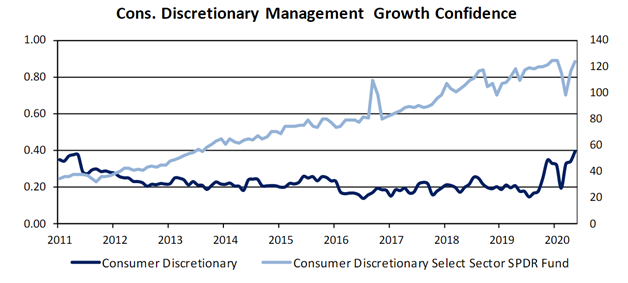This indicator is a powerful tool that helps investors gain crucial insights into individual sector movements through the eyes of management teams

When talking about macro trends, people often think of the market as one uniform entity. In reality, different areas of the market can move in very different ways over time.
Using our Earnings Call Forensics framework, we can monitor trend in management sentiment, not just for the market as a whole, but for different individual industries and sectors. This way, we can identify where some parts of the market may see stronger or weaker fundamental momentum than others.
Right now management teams in the Consumer Discretionary and Communication Services sector are showing confidence, while management in the Real Estate sector are growing much more pessimistic.
Investor Essentials Daily:
The Monday Macro Report
Powered by Valens Research
Investment research often focuses on the movement of a stock index, such as the Dow Jones or S&P 500. It is inherently easier to discuss the movement of a single number than to break down different sectors’ movements.
There are of course winners and losers in any market, bull or bear, but this shorthand tends to work well, as individual stock movements tend to correlate as they rise. Every stock may not move by the same amount, but for the most part, everyone is rising or falling.
During the past six months, this relationship has broken down in a particularly significant way as different industries are transforming due to disruptions from the coronavirus.
For example, travel companies such as Expedia (EXPE) and TripAdvisor (TRIP) have been severely impacted by travel restrictions. Meanwhile, firms such as Netflix (NFLX) and Zoom (ZM) have seen demand for their online services explode.
When only talking about the market, it’s easy to miss these large stock swings in the aggregate. For a news station, it’s easier to look at the movement of the S&P 500 or Dow Jones as there is only one number to talk about.
Last month, we showed how our Earnings Call Forensics analysis captured management’s confidence across the market. Considering the winners and losers in the current market environment, it can be valuable to understand the dispersion of management’s confidence across different sectors.
The charts included show management sentiment plotted out over the last few years for each sector.
Surprisingly, the sector which saw the largest rebound in management confidence over the past few months has been Consumer Discretionary.
As the chart below shows, management confidence (dark blue line—higher is “more positive”) has reached decade-high levels in the second quarter of 2020.
Considering how the retail, restaurant, and travel industries in particular have been disrupted since March, this would be surprising initially.
However, for firms such as homebuilders, internet retailers, online education, and consumer electronics firms, the recent period has led to increased demand for their products, not a reduction.
As importantly, for retailers and other industries that have been disrupted, the signs of a successful acceleration in re-opening in May and early June, appeared to have led to management teams getting more bullish about their outlooks.
Meanwhile, management confidence in the Communication Services sector has also recovered to 2018 highs.
The Communication Services sector includes cable and telecom companies, and the online and regular media companies that have benefited significantly from more people spending time at home, using more internet, and needing to get wired at home to do work remotely.
Management within the Communication Services sector appear to be seeing that demand in their products have remained steady, and for some have surged, in the at-home revolution.
On the other hand, unsurprisingly one of the sectors that has seen the biggest dip in management confidence has been the Real Estate sector.
Since the pandemic started management confidence in the Real Estate sector has fallen from 9 year high levels to historical low levels for the sector.

As mentioned, this isn’t surprising as the Real Estate sector is currently under tremendous pressure.
The commercial real estate universe is being thrown into upheaval. There are real questions about ongoing demand for office space after the pandemic recedes, as more people continue to work from home.
For retail, restaurant, and hotel REITs, similarly, there are concerns about the viability of their tenants, because of closing restaurants and brick and mortar retailers, and because hotels might see a slower recovery than initially hoped.
Also, for residential REITs, two different pressures are impacting them. Firstly, in the near-term, rents are being disrupted as people continue to be out of work. That’s hurting income. Also, longer term, the same surge in demand for homebuilders is a negative for these companies.
Looking back at the pandemic and looking at the reduced concerns about a commute if there will be more working from home, many people are more interested in moving out of the city, and out of apartment complexes. This could be a secular headwind for these businesses.
To understand how the market is moving, it is crucial to understand management’s outlook. While many management teams are confident about the future, there are just as many who see the at-home revolution as a curse rather than a blessing.
While analysis of marketwide trends is still crucial, investors should also be thinking about the impact of how individual sectors have shaped the changing trend, and then re-thinking how to allocate their assets.
Best regards,
Joel Litman & Rob Spivey
Chief Investment Strategist &
Director of Research
at Valens Research






